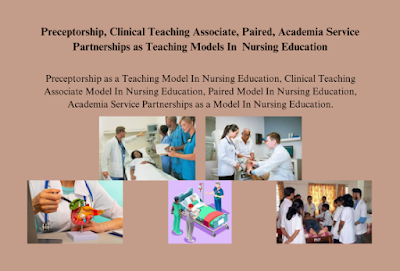The Preceptorship as a Teaching Model and Clinical Teaching Associate (CTA) Model. Teaching Models In Nursing Education Nursing Education Models: Preceptorship, Clinical Teaching Associate, Paired, and Academia-Service Partnerships
The Preceptorship as a Teaching Model and Clinical Teaching Associate (CTA) Model
An experienced professional officially assigned for a specific period of time to support a student or physician during the transition to a new practice setting through role modeling, teaching, and social interaction.
Professionals must have a passion and aptitude for teaching, including mastery of the four roles they fulfill in teaching clinical problem-solving (teaching, modeling, coaching, and facilitating).
Preceptorship as a Teaching Model
Preceptorship is a hands-on teaching approach where students are paired with experienced nurses, known as preceptors, who mentor and guide them during clinical rotations. This model is designed to bridge the gap between theory and practice, providing a one-on-one learning environment that promotes professional socialization and application of theoretical knowledge.
Key Aspects of Preceptorship:
- Role of Preceptors: Preceptors facilitate learning by providing guidance, support, and role modeling. They are typically experienced nurses who integrate teaching with their regular patient care responsibilities.
- Triad Model: In some settings, the preceptor, student, and faculty form a triad to support and evaluate the student’s learning. This model involves pre-meetings to discuss learning goals and the use of formative and summative evaluations.
- Integrative Clinical Preceptor Model: This model emphasizes the student’s proactive role and the preceptor’s responsibilities as a teacher, mentor, and role model, with faculty acting as consultants and facilitators.
- Benefits: Preceptorship enhances the application of theory, improves psychomotor skills, increases self-confidence, and supports professional socialization. The model also helps preceptors develop teaching skills and provides clinical agencies with well-prepared graduates.
Clinical Teaching Associate (CTA) Model
The Clinical Teaching Associate model involves a staff nurse who works alongside a faculty member to teach and guide students in the clinical setting.
Key Aspects of the CTA Model:
- Role of CTA: CTAs take on teaching responsibilities, serving as role models and resource persons for students. They work closely with faculty to plan and supervise clinical learning experiences.
- Faculty Role: Faculty oversee the overall clinical experience, including grading and collaboration with CTAs on assignments and student performance.
- Benefits: This model has been shown to improve patient satisfaction, increase student confidence, and enhance learning experiences compared to traditional models. It also allows students to assume more responsibility in their clinical practice.
Paired Model
The Paired Model involves pairing a student with a staff nurse for part of their clinical experience, while the rest of their time is spent in a traditional clinical setting.
Key Aspects of the Paired Model:
- Pairing: Students and staff nurses are paired for a set period, often within community-based settings like clinics or ambulatory care centers. This pairing allows students to gain hands-on experience while receiving guidance from experienced practitioners.
- Faculty Role: Faculty members oversee the learning environment and are responsible for planning and evaluating experiences, though their time is also divided between paired and traditional student groups.
- Benefits: The paired model allows for personalized learning experiences and can be particularly effective when combined with other educational models.
Academia-Service Partnerships
Academia-Service Partnerships are collaborative models between academic institutions and healthcare services aimed at enhancing nursing education and addressing faculty shortages.
Key Aspects of Academia-Service Partnerships:
- Collaboration: These partnerships involve sharing resources and responsibilities between academic institutions and clinical agencies. Examples include integrating clinical nurse specialists (CNS) as adjunct faculty members and collaborating on patient assignments and student evaluations.
- Benefits: These partnerships help create new clinical education models, increase student and faculty capacity, and improve integration into clinical settings. They also enhance students’ critical thinking and clinical decision-making skills.
- Communication: Effective communication between faculty and clinical staff is crucial for addressing issues affecting student performance and ensuring a cohesive learning experience.
Conclusion
Each of these models—Preceptorship, Clinical Teaching Associate, Paired, and Academia-Service Partnerships—offers unique benefits and approaches to clinical nursing education. By implementing these models, nursing programs can enhance student learning, address faculty shortages, and improve overall clinical education experiences.
What is Preceptorship as a Teaching Model and Clinical Teaching Associate (CTA) Model?
How is Preceptorship as a Teaching Model and Clinical Teaching Associate (CTA) Model?
Why is Preceptorship as a Teaching Model and Clinical Teaching Associate (CTA) Model?
Read More:
https://nurseseducator.com/didactic-and-dialectic-teaching-rationale-for-team-based-learning/
https://nurseseducator.com/high-fidelity-simulation-use-in-nursing-education/
First NCLEX Exam Center In Pakistan From Lahore (Mall of Lahore) to the Global Nursing
Categories of Journals: W, X, Y and Z Category Journal In Nursing Education
AI in Healthcare Content Creation: A Double-Edged Sword and Scary
Social Links:
https://www.facebook.com/nurseseducator/
https://www.instagram.com/nurseseducator/
